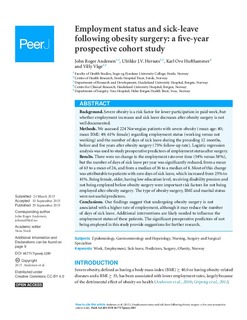| dc.contributor.author | Andersen, John Roger | |
| dc.contributor.author | Hernæs, Ulrikke J.V: | |
| dc.contributor.author | Hufthammer, Karl Ove | |
| dc.contributor.author | Våge, Villy | |
| dc.date.accessioned | 2016-02-01T14:19:13Z | |
| dc.date.available | 2016-02-01T14:19:13Z | |
| dc.date.issued | 2015 | |
| dc.identifier.citation | Andersen, J., Hernæs, U., Hufthammer, K., & Våge, V. (2015). Employment status and sick-leave following obesity surgery: A five-year prospective cohort study. PeerJ, 3, E1285. | nb_NO |
| dc.identifier.issn | 2167-8359 | |
| dc.identifier.uri | http://hdl.handle.net/11250/2375560 | |
| dc.description.abstract | Background. Severe obesity is a risk factor for lower participation in paid work, but whether employment increases and sick leave decreases after obesity surgery is not well documented.
Methods. We assessed 224 Norwegian patients with severe obesity (mean age: 40; mean BMI: 49; 61% female) regarding employment status (working versus not working) and the number of days of sick leave during the preceding 12 months, before and five years after obesity surgery (75% follow-up rate). Logistic regression analysis was used to study preoperative predictors of employment status after surgery.
Results. There were no change in the employment rate over time (54% versus 58%), but the number of days of sick leave per year was significantly reduced, from a mean of 63 to a mean of 26, and from a median of 36 to a median of 4. Most of this change was attributable to patients with zero days of sick leave, which increased from 25% to 41%. Being female, older, having low education level, receiving disability pension and not being employed before obesity surgery were important risk factors for not being employed after obesity surgery. The type of obesity surgery, BMI and marital status were not useful predictors.
Conclusions. Our findings suggest that undergoing obesity surgery is not associated with a higher rate of employment, although it may reduce the number of days of sick leave. Additional interventions are likely needed to influence the employment status of these patients. The significant preoperative predictors of not being employed in this study provide suggestions for further research. | nb_NO |
| dc.language.iso | eng | nb_NO |
| dc.publisher | Peer J | nb_NO |
| dc.rights | Navngivelse 3.0 Norge | * |
| dc.rights.uri | http://creativecommons.org/licenses/by/3.0/no/ | * |
| dc.subject | epidemiology | nb_NO |
| dc.subject | gastroenterology and hepatology | nb_NO |
| dc.subject | nursing | nb_NO |
| dc.subject | surgery and surgical specialities | nb_NO |
| dc.subject | sick-leave | nb_NO |
| dc.subject | predictors | nb_NO |
| dc.subject | obesity | nb_NO |
| dc.subject | employment | nb_NO |
| dc.subject | work | nb_NO |
| dc.title | Employment status and sick-leave following obesity surgery: A five-year prospective cohort study | nb_NO |
| dc.type | Journal article | nb_NO |
| dc.type | Peer reviewed | nb_NO |
| dc.source.pagenumber | 12 | nb_NO |
| dc.source.journal | PeerJ | nb_NO |
| dc.identifier.doi | 10.7717/peerj.1285 | |
| dc.identifier.cristin | 1289977 | |

